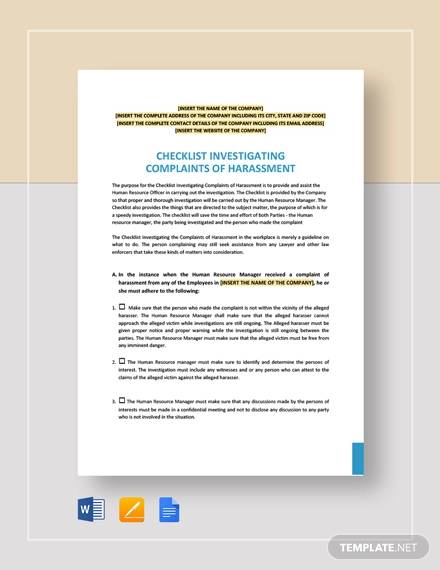What is harassment? It is said that harassment takes place when an individual gets intimidated, offended, or aggressively pressured by another. Harassment includes a number of behaviors that are offensive in nature and threatening. They are believed to have a repetitive characteristic, like that of the cycle of violence in abuse.
In the workplace, the number of sexual harassment and employees getting sexually harassed by their employers or co-employees are increasing each year. Although there are male victims, there are still a lot of sexual harassment complaints coming from female victims. In order to handle a harassment complaint, one needs the aid of harassment investigation checklist.
Sample Checklist Investigating Complaints of Harassment

Why Is There a Need to Investigate Harassment?
Harassment, or sexual harassment, is a serious matter and should not be taken lightly. The fact that harassment is a repetitive behavior is one of the things to be serious about. As humans, we get tempted to do a lot of different bad things that even logic and reasoning cannot defeat. To stop harassment, it should be addressed. Well, you can’t just accept a harassment complaint just like that. You first need to do an investigation. Below are the reasons why you need to investigate harassment.
- Not all harassment complaints are true. There are complaints made because a certain individual is just too paranoid about being harassed by another individual. True, harassment is often identified by an individual if they feel that they are being harassed and it is their right to report it. However, it is not all the time legal, that is why an investigation is done to determine or prove that the act was really that of harassment.
- Some people just pretend or make up stories that they are being harassed by a particular person. Because of the impact of harassment on society, a lot of people take advantage of it by spreading rumors that this person harassed them even if they really didn’t. True or not, this person’s reputation will be tainted for the rest of his/her life and they might get fired at work. Through investigations, claims and accusations like this can be cleared. Investigating harassment can definitely save one’s life and reputation.
- Anybody can be harassed and anybody can be the harasser. Being a manager or a high-ranking official does not guarantee being innocent. A lot of harassment cases that have been investigated show that people who are in high-ranking positions are prone to harassing their female employees, either sexually, physically, or mentally.
- There are a lot of cunning people out there who just know how to keep things in order and who know how to get away with harassment claims. If not investigated thoroughly, their claim to innocence might just be awarded to them. So they clean their names and record and start to harass anew. It could be a new employee or it could be in a new place or location.
Harassment investigations need to be done thoroughly as every detail and every data gathered in this investigation will help determine if a harassment complaint is valid or not. It would be unfair if harassment claims are accepted as facts without undergoing due process.
What Factors Can Complicate the Harassment Investigation Process?
Investigations are done in order to get the facts about certain events and point out the truth. It’s actually easier said than done. There are things that complicate harassment investigations making it difficult for the investigators to get the truth. The following are the factors that complicate harassment investigations.
- The absence of physical or actual evidence
- Having two sides of the story, or an individual’s words against another
- There is exaggeration with the details being provided by both the involved parties
- Information that is withheld by the parties involved
- Personal motives that usually causes the exaggeration of details and withholding of important information
Is It Important to Use a Checklist When Conducting a Harassment Investigation?
Checklists help in making sure that tasks are done thoroughly. Just like in a to-do list, a checklist makes it easy to remember tasks so that they can all get done on time. When conducting harassment investigations, it is important to make use of a checklist for it provides a lot of benefits to both the investigator and the investigation.
- A checklist helps in the preparation of an organized harassment investigation. Even when doing investigations, it is important that it is done in an organized manner. Harassment cases can be chaotic and dramatic, so if you as an investigator are not organized, then you will definitely lose your way to the truth in the investigation and your findings will be as disorganized as the situation.
- A checklist contains a complete list of the tasks that need to be done before an investigation, during an investigation, and after an investigation. All of the tasks that are involved in an investigation are important, that is why using a checklist as a guide is a really great help.
- A checklist helps in reminding the investigator the steps that they have already taken and the steps in the investigation process that they have yet to accomplish. This allows a smooth sailing and organized investigation to be conducted.
- A checklist can be used in the brainstorming process of the investigation as a form of data collector or record keeping tool. If there is a need for investigators to recall something from previous investigations, they can always look at the checklists of old or existing harassment investigation and gather data from there.
A checklist is not only helpful when conducting harassment investigations but has many other different uses. They can be used as audit checklists, termination checklists, and pre-employment checklists.
Is Flirting a Form of Sexual Harassment?
As adults, we’re all familiar with flirting. Not that we do the act ourselves, but we see men and women flirt. We understand from their gestures, conversations, and actions when a certain individual is flirting with another. This seems to be fine as it is somewhat considered normal, especially when flirting in a friendly way. So when does flirting become sexual harassment? Flirting becomes harassment when things get too far and too uncomfortable to the point that it is causing trouble. Below are the instances when flirting becomes harassment.
- Flirting becomes sexual harassment when an individual is going too far with their actions and words that it is becoming scary or creepy to the other individual.
- Flirting becomes sexual harassment when an individual forces it to the other individual who clearly doesn’t want it—in other words, not mutual.
- Flirting becomes sexual harassment when it is done in the wrong environment and when the actions of the other are inappropriate.
- Flirting becomes sexual harassment when one individual sends unwanted text messages, emails, photographs to another individual. This also includes making unwanted phone calls and frequent visits to the other individual’s house or living quarters.
- Flirting becomes sexual harassment when an individual talks indecently and offensively to the other individual.
- Flirting becomes sexual harassment when an individual touches the other individual in a malicious way, without consent or approval.
Courtship and relationships usually start with flirting. Flirting could be something good as long as it is done appropriately at the right time, with the right person and in the right environment.
What Are Some Examples of Harassment?
Harassment comes in different forms, not just sexual harassment. We have gathered some examples of harassment that are worth knowing. They are provided below.
- Sexual Harassment – Examples of sexual harassment include having physical contact with another individual without their consent, invading the personal space or privacy of another individual, jokes or comments that are unwanted and are sexual in nature, and verbal threats to name a few.
- Bullying – This includes getting humiliated in public, abuse of power or power tripping, unjustified criticism, verbal threats, and intimidation.
- Racial Harassment – This includes name-calling that is derogatory, racist jokes, and racist insults and getting attacked physically.
- Political and Religious Harassment – Getting ridiculed, offensive jokes and displaying of materials that are offensive.
- Verbal and Mental Harassment – This includes demeaning words, derogatory name-calling, unwanted comments and stories that are made up to make an individual look bad and feel bad about themselves.
- Physical Harassment – This could be in the form of physical abuse and unwanted contact that is forced by another individual.
Can You Take Someone to Court for Harassment?
Harassment is both a serious and a scary matter. If you are harassed, you wouldn’t want to stay silent about it; act brave and pretend that nothing happened. You would want to call or go to the police and file a police report of what happened. If you think calling or filing an incident report to the police is not enough, you can take the person harassing you to court. You read it right.
The court will decide if the harassment case is meant to be heard in the civil court or if it is under the Harassment Act of 1997. This act serves as every individual’s protection against any forms of harassment, especially those that are causing distress to a lot of individuals.
Related Posts
FREE 18+ Complaint Checklist Samples in MS Word | Google Sheets | PDF
FREE 18+ Internship Checklist Samples in MS Word | Google Docs | PDF
FREE 18+ Statement Checklist Samples in MS Word | Google Sheets | PDF
FREE 20+ Voluntary Checklist Samples in MS Word | Google Sheets | PDF
FREE 18+ Summary Checklist Samples in MS Word | Google Sheets | PDF
FREE 14+ Sponsorship Checklist Samples in MS Word | MS Excel | PDF
FREE 18+ Conference Checklist Samples in MS Word | Google Sheets | PDF
FREE 17+ Lesson Checklist Samples in MS Word | Google Sheets | PDF
FREE 18+ Progress Checklist Samples in MS Word | Google Docs | PDF
FREE 18+ Enrollment Checklist Samples in MS Word | Google Docs | PDF
FREE 18+ Graduation Checklist Samples in MS Word | Google Sheets | PDF
FREE 15+ Consent Checklist Samples in MS Word | Google Sheets | PDF
FREE 18+ Review Checklist Samples in MS Word | Apple Pages | PDF
FREE 18+ Submission Checklist Samples in MS Word | Google Docs | PDF
FREE 18+ Request Checklist Samples in MS Word | MS Excel | PDF
